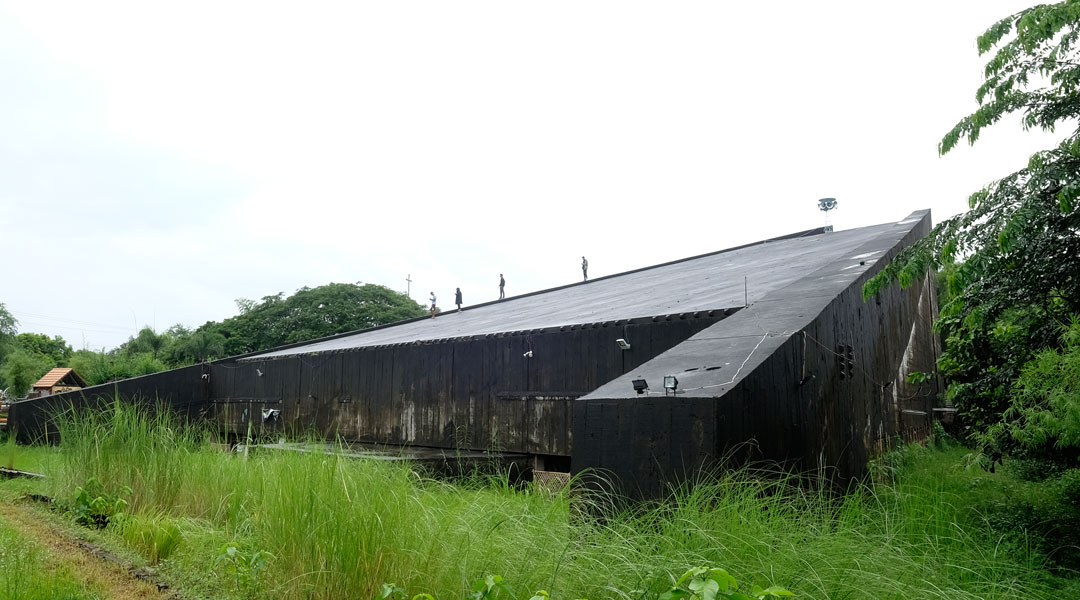
The Sunken Cabetican Shrine in Pampanga is Unsinkable in Spirit
To enter the Sunken Shrine of Our Lady of Lourdes of Cabetican, you have to get on bended knee and crouch through meter-high openings in the massive walls of the church. On the day of our visit, flooding caused by heavy rain the night before made the east and main entryway impassable, leaving the opening at the west façade the better means of entry. The distance one traverses to get inside the church is a mere 1.7 meters, but the experience can be a transformative one. Shuffling through the truncated space at a crouch, or on hands and knees as some do, the light gets progressively dimmer.
In the growing darkness, you hear and feel the grit of the floor and the rough concrete above your head so much more acutely, and imagine the crushing weight of the wall above. The earthy smell of rain, grass, and damp soil takes over. These sensations are not all that alien, but in those few seconds, it is like entering the unknown. One cannot help but feel meek and uncertain. And then, stepping into the vast space of the shrine, your eyes adjust to the muted light coming from the half-disc skylight above the altar, and the feeling of a great burden and unease lifts.

“The lahar didn’t stop after the eruption of Mt. Pinatubo in 1991,” says one of the church caretakers, Estelita Panlilio, the mother of the parish priest. “It continued to flow in 1995, and the local government decided to divert its course away from Angeles City and into Bacolor. The diversion resulted in the flooding of most of the villages in the town.”
READ MORE: Revisit the stories behind 7 heritage Batangas churches this Holy Week
Hundreds died in the floods. The tragedy forever changed the town, including the relatively new archdiocesan shrine, Pampanga’s first, which was built to take in the growing number of pilgrims who flocked to Cabetican for its miraculous image of Our Lady of Lourdes. Dedicated to the town in 1901, the image was originally housed in a small chapel of bamboo and nipa.
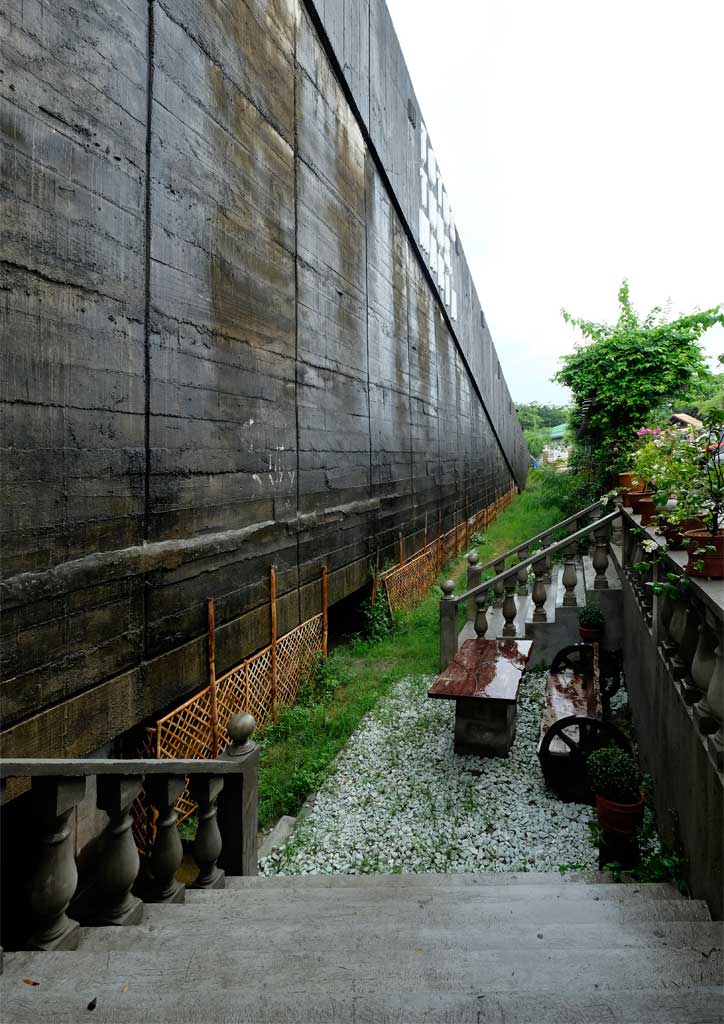
The product of fervent devotion and popular pilgrimage, the Church of Our Lady of Lourdes of Cabetican was built in 1985 in the Brutalist style, following the prevailing architectural aesthetic of the time. The religious structure stood out as an imposing modern edifice for its 84-year-old occupant, unique in a province teeming with florid and opulent heritage churches.
The shrine’s leap into significance and modernity was helmed by noted Pampagueño engineer Julio Macapagal, who, with a team of seven architects whose identities remain curiously unknown, designed an irregular trapezoidal shrine with a sloping roof. It measures 59.7 meters at the east face, 56.6 meters at the west face, and 36.8 meters at the south. The north face is the narrowest at 10.6 meters, where the roof soars to its present height of 12.7 meters.
After disaster struck in 1995, the whole district of Cabetican and much of Bacolor was left submerged in a layer of lahar three to six meters thick. The Cabetican Shrine was one of the structures of note badly affected, along with its more famous neighbor, the San Guillermo Parish Church. The statue of Our Lady was evacuated in the nick of time and transferred to St. James’ Parish in Betis. Meanwhile, the shrine lay unusable and in disrepair for a decade until the national government spearheaded restoration efforts in 2005, in partnership with the local government of Bacolor and the parish.
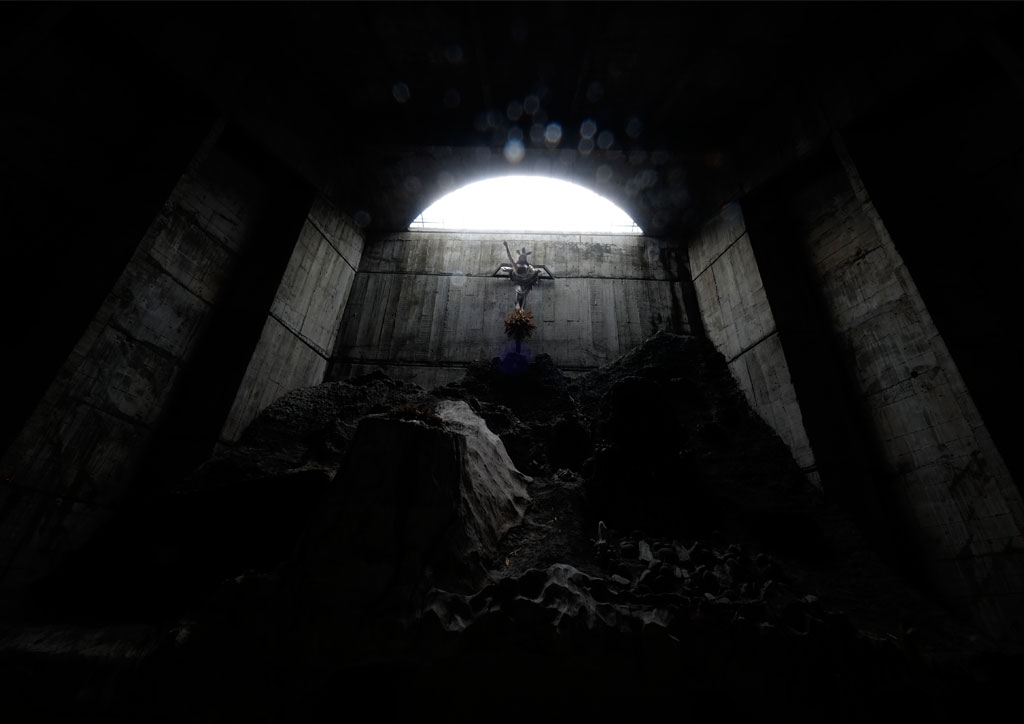
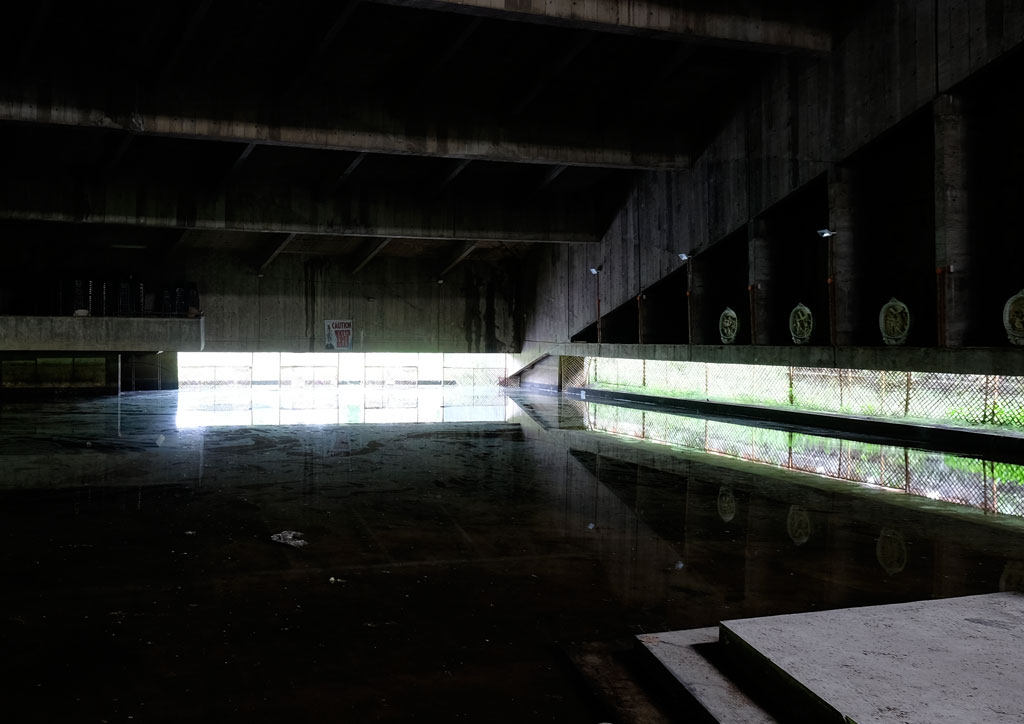
Unfortunately, Engineer Macapagal had already passed, and none of the seven local architects involved in the project had come forward. With church and municipal records lost to lahar, and without vital information on its structural makeup, the restoration team performed only a partial excavation, freeing up just enough space to gain entry into the church and use the interiors, a solution also resorted to at San Guillermo.
The community did not dare to have the church dug up any deeper, as no one knew what condition the submerged walls were in, and a lower floor level would only spell higher flood levels inside the church during monsoon season. As it is, water levels in the church sometimes reach a meter high. The parishioners dismantled the grand chandeliers that once hung loftily over them but now humbly scraped the ground of hardened lahar. Unassuming spotlights took their place to illumine the dark and musty interiors that had not seen human presence for years.
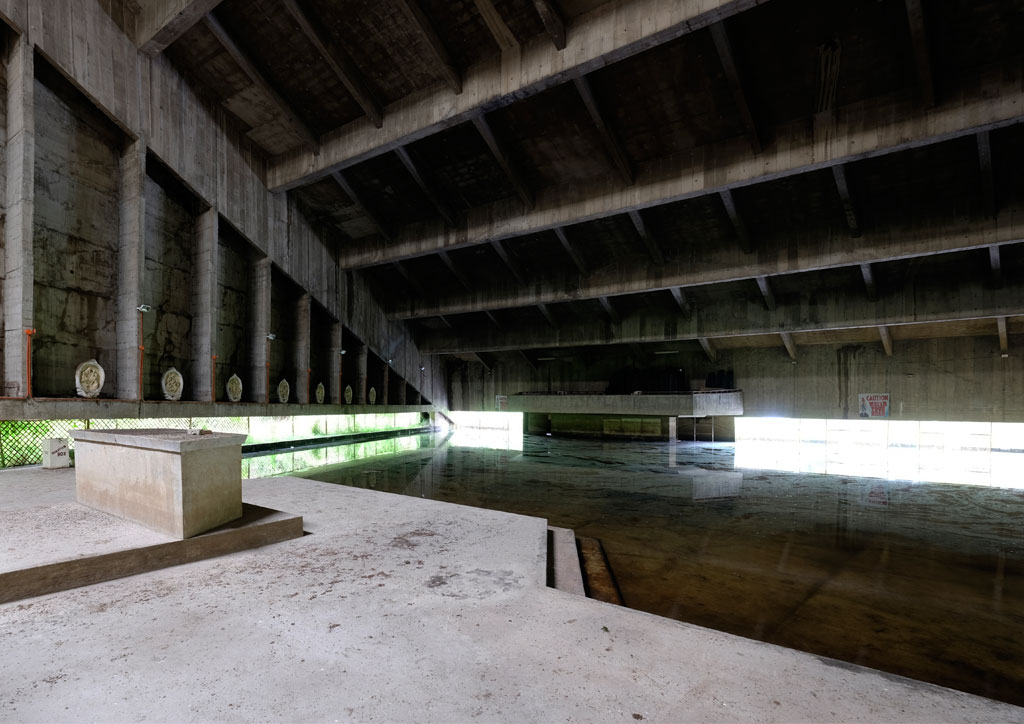
The caretakers and locals present during our shoot posit that five to six meters of the church still lie underground. They describe the 1985 Cabetican Shrine as a daunting and massive presence. At the height of 18 meters (some insist 24 meters), it would indeed have been formidable.
The lofty ceiling of San Sebastian Basilica in Quiapo, Manila, for example, is 18 meters high at the nave and 30 meters high at the dome. Relative to the ceiling height, San Sebastian’s narrow width (12 meters) and length (35 meters) enhance the basilica’s verticality and elongation, making it a distinctly exalted processional space. In contrast, the trapezoidal Cabetican Shrine was three times as broad as it was tall, giving it the atmosphere of a large meeting space, a design intent affirmed by the original amphitheater-style seating.
Perhaps most significantly, the loss of height has also brought the congregation closer to the object of their devotion.
The loss of six meters of height has made the Cabetican Shrine a markedly horizontal space, now almost five times as broad as it is tall at the peak. The amplified horizontality and expansiveness of the temple engenders feelings of calm, serenity, and stability. The lower ceiling seems to speak of man’s relationship with the Earth and his fellow man.
The cantilevering choir loft at the southern end of the church now hovers a mere 0.6 meters or two feet from the floor instead of the original 6.6 meters, another visual that imparts a message of humility and connection. Perhaps most significantly, the loss of height has also brought the congregation closer to the object of their devotion.
Mt. Pinatubo’s fury may have severely altered aspects of the Cabetican Shrine, but the changes are not incongruous—and may even be more in keeping—with its raw and unpretentious architecture. This doesn’t mean the church is without a sense of exaltation. The 25-degree slope of the roof leads mind and spirit heavenward, and the eye to an imposing retablo, which has none of the gilt and lavish ornamentation that characterize most Filipino heritage churches. The cold concrete textures, the rocky altar face, and the low lighting all contribute to the cavern-like atmosphere that is no less daunting than before, has become much more austere, and is curiously intimate.
READ MORE: Sugarlandia Visita Iglesia: 5 Bacolod churches to visit this Holy Week
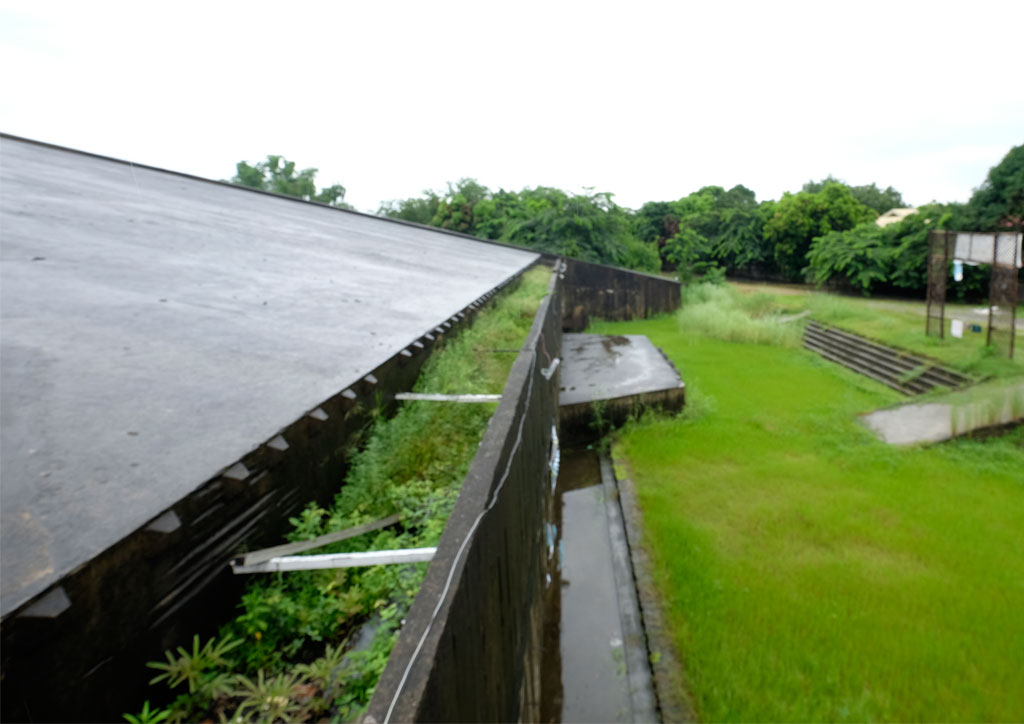
The return of the beloved church to its congregation is a triumph on many counts. It stands for the unsinkable spirit of the community, the victory of life over death, and, yes, even the unassailability of good architecture.
And lest one be tempted to feel self-righteousness or self-satisfied after time spent pondering the ineffable and the infinite, the journey on the way out, just like the journey in, compels one to bow the head and bend the knee in humility. It is always a good state of heart in which to face the world that waits outside. ![]()
Frequently Asked Questions (FAQs)
The Sunken Church in Pampanga, also called the Cabetican Shrine of Our Lady of Lourdes, is a partially buried church that remains a symbol of faith despite being submerged.
The shrine is located in Barangay Cabetican, Bacolor, Pampanga, a town known for its resilience after the devastation caused by the Mount Pinatubo eruption.
The church was buried by lahar flows and volcanic debris after the Mount Pinatubo eruption in 1991, leaving only the upper portions visible today.
Built before the eruption, the shrine became a place of refuge and prayer. Even after being buried in a lahar, it continues to be a landmark of devotion and survival.
Visitors must crouch or crawl through low openings in its walls, with entryways often affected by rainwater or flooding, adding to the unique experience.
Original article first appeared in BluPrint Vol 4 2017. Edits were made for BluPrint online.


